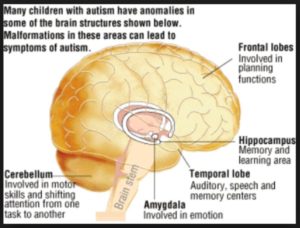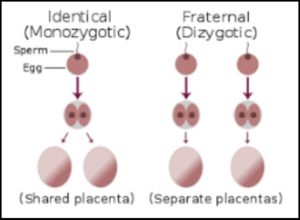Causes of Autism: Genetic, Environmental or Both?
Identifying causes of Autism Spectrum Disorders (ASD) has been really a big challenge for the researchers. Scientists and medical professionals have struggled to understand the exact causes of autism for many years. It is widely accepted that ASD is a neurodevelopmental disorder marked by abnormalities in brain structure and function. The brain scan shows the differences in the shape and structure of the brain in autistic versus non-autistic individuals. Initially, the researchers assumed that the irregular segments of genetic codes might be the root causes of autism. But there is no conclusive evidence why and how it happens. In the recent studies, the environmental factors are also considered as the causes of autism.
 Studies have suggested that parents who have a first child with autism have higher chances of having a second child with autism compared to the general population. Many researchers believe the increase in the number of cases of ASD worldwide is due to a combination of genetic and environmental factors.
Studies have suggested that parents who have a first child with autism have higher chances of having a second child with autism compared to the general population. Many researchers believe the increase in the number of cases of ASD worldwide is due to a combination of genetic and environmental factors.
However, a growing area of research indicates that the causes of ASD may be an interaction of genetic and environmental factors. The researchers and medical professionals recently found that genetics only account for 37 percent of cases, while the environment accounts for 55 percent of them.
In this article, I would like to discuss the probable causes of ASD predicted at different times depending on the researches of the scientists and medical professionals.
Refrigerator Mother Theory
Refrigerator Mother Theory stated that autism is caused by lack of maternal warmth. In 1943, Leo Kanner first identified autism and stated the lack of warmth among the parents of the autistic children as the cause of it. Parents, particularly mothers, were often blamed for their children’s atypical behavior, which included rigid rituals, speech difficulty, and self-isolation. However, Leo Kanner, later rejected the ‘Refrigerator Mother Theory’, instead focusing on brain mechanism.
Later on, in the 1960s and 70s, Dr. Bernard Rimland, the founder of the Autism Society of America and the Autism Research Institute (ARI) opined that autism is not caused by cold parents rather it is a biological disorder.
So, it is an established fact that the ASD is not caused by any wrongdoing by the parents while raising their children.
Genetic Causes of Autism
Most of the researchers on ASD think that the genes may play an important role in the development of ASD. Latest researches estimate that the scientists have been able to discover dozens of genes that contribute to ASD. Studies have shown that the twins and siblings are affected by ASD in many cases. So, the researchers started twin studies which have found a large influence of the gene as causes of autism.
“Taking a family health history would be important, because if there is already someone with autism spectrum disorders, and the study is correct, then the likelihood of another person having it in the family is higher.” —Charis Eng, MD, PhD.
Followings are the common opinions of the genetics researchers regarding autism at different times (Source):
- “Autism is clearly among the most heritable of all psychiatric disorders“(2003);
- “Autism is one of the most heritable complex disorders, with compelling evidence for genetic factors and little or no support for environmental influence” (2004);
- “Autism spectrum disorders are considered to be among the most heritable of all mental disorders…. recent reviews estimate the heritability of autistic disorder to be more than 90%.” (2010);
- “ASDs are known to be highly heritable (~90%)” (2010).
British Autism Twin Study in 1977. British scientists Susan Folstein and Micheal Rutter conducted a study on ASD with 21 same-sexed pairs of British twins first in 1977. Among them, 11 pairs were identical (monozygotic) and 10 pairs were fraternal (dizygotic) twins. The study found that only 4 of the identical twin pairs were concordant for autism. The British Team declared “The estimates of broad heritability were 93% and 91% for the base rates of 1.75 and 10 in 10,000.” Since then it has been strongly believed that autism is more than 90% genetic disorder. But the research continued as there was no conclusive evidence.

British Autism Twin Study in 1995. The British team of scientists conducted another study in the year 1995 by recruiting 28 pairs of twins. They also kept the twin groups from their earlier study. They found 11 identical pairs out of newly recruited 16 identical pairs with an autism concordance rate of 69%. On the other hand, only one pair of the fraternal pair was concordance for autism. (Source)
The Child and Adolescent Twin Study in Sweden (CATSS)2004. The CATSS data has been shown that the heritability for ASD was around 80% and that ASD had a common genetic etiology with other neuropsychiatric disorders, that extreme values of ASD and ADHD have the same genetic etiology as normal variation in the underlying traits, and an association between fetal growth on ASD suggesting that fetal growth is in the causal pathway.
California Autism Twin Study (CATS) in 2004-2009. CATS is the largest twin study, enlisted from a registry based on the entire California autism population and including a final sample of 192 twin pairs, more than four times larger than any other previous twin study and nearly an order of magnitude larger than the first British and Scandinavian studies. The CATS identical twins had lower and the fraternal twins higher concordance rates than past studies. The California twins raised the idea that “heritability estimates from previous studies may have overestimated the role of genetics and underestimated the role of environmental factors in the etiology of autism.” The results of the study suggest that environmental factors common to twins explain about 55% of the liability to autism. Although genetic factors also play an important role, they are of substantially lower magnitude than estimates from prior twin studies of autism. (Source)
Twin studies have suggested as many as 9 out of 10 children with autism inherited the condition through their combination of genes, though other studies have also put a more conservative estimate down towards 60 percent. One study published in 2011 conducted by researchers from Stanford University in California put the chances of genetic heritability at around 38 percent for ASD. Another analysis conducted in 2014 also calculated a lower number, nearer to just 50 percent.
The researchers have arranged several studies since the 1970s to find out the causes of autism. The studies have shown that identical twins have a much higher concordance rate of ASD than fraternal twins who are not genetically identical. It was evident from the studies that these disorders have a strong genetic component. Again, the concordance rate for identical twins is not 100%, which suggests that at least some cases must be associated with environmental or epigenetic factors.
Environmental causes of autism
“It’s time to start looking for the environmental culprits responsible for the remarkable increase in the rate of autism.” – Irva Hertz-Picciotto, Epidemiology Professor at University of California, Davis. (source)

The environment is being polluted always by different chemicals throughout the year. Only in the USA, about 1 billion pounds of pesticides are sprayed on the foods every year and the amount is about 5.6 billion pounds throughout the world.
The researchers have also suspected that a faulty gene or genes might make a person more likely to develop autism when there are also other factors present, such as a chemical imbalance, viruses or chemicals, or a lack of oxygen at birth.
For example, a study of the University of California, Davis, determined that pregnant women who live in close proximity to land and farms where chemical pesticides were applied, experienced a two-thirds increased risk of having a child with autism spectrum disorder or some other developmental disorder. Prenatal exposure to the chemicals thalidomide and valproic acid has been linked to increased risk of autism.
“Because of the observed associations in humans and direct effects on neurodevelopmental toxicity in animal studies, caution is warranted for women to avoid direct contact with pesticides during pregnancy.”(source)
Some of the world’s leading experts published a new list of highly suspect chemicals (PCBs, Organochlorine Pesticides, Automotive Exhaust, Brominated Flame Retardants, Polycyclic Aromatic Hydrocarbons, Organophosphate Pesticides, Hormone-Disrupting Chemicals, and Nonstick Chemicals) and heavy metals (lead & mercury) believed to be behind the surge in cases of autism and other neurodevelopmental diseases.(Source)
Pregnant women who catch flu or have a fever that lasts over one week have a higher risk of giving birth to a baby with an ASD (autism spectrum disorder), researchers from the University of Aarhus, Denmark, reported in the journal Pediatrics published on November, 12th, 2012.
Researchers have demonstrated with the largest ever multinational study of parental age and autism risk that the children of teen mothers, older parents, and parents with an age gap of 10 years or more have a higher risk of autism spectrum disorder than other children.(Source)
Researchers have found that pregnant women who take the drug valproate (for epilepsy) could be at an increased risk of giving birth to a child with autism, according to a new study published in the journal JAMA.
Babies who are above average in size when they are born are at a greater risk of autism, as well as those who are born below average in size, according to the biggest study of fetal growth and autism to date.—The American Journal of Psychiatry
Exposure to traffic-related air pollution, nitrogen dioxide, and particulate matter during pregnancy and during a child’s first year of life may be linked to a higher risk of autism.—Archives of General Psychiatry, a JAMA Network publication.
In 1998, a study raised concerns about a possible link between the MMR – measles, mumps, rubella – vaccine, and autism, setting off widespread panic around the world. The study had its flaws: it was based on only 12 children, and the researchers didn’t find a link between the MMR vaccine and behavioral problems. Ten of the 13 authors of the paper said they shouldn’t have published the paper. (Source)
In April 2015, the Journal of the American Medical Association (JAMA) published the largest-ever study comparing autism rates among vaccinated versus unvaccinated children. The investigation – which followed more than 95,000 children – echoed previous research in finding no link between autism and the measles-mumps-rubella vaccine.
Conclusion
Autism is a complex neurodevelopmental disorder. Scientists and medical professionals are conducting extensive research for last 75 years after its identification in 1943 to find out the causes of autism. But none could find out the actual causes of autism in a child. Some researchers thought it to be absolute genetic causes, whereas other assumed it would be environmental causes, and some hypotheses were the combination of both. The researchers have shown the different percentage of genetic and environmental causes but there was no conclusive evidence about it. From the different findings of the researchers, the involvement of the environment or other non-genetic causes for ASD cannot be over-ruled. But we have to wait for some suitably powered and well-designed study to come forward to know the exact causes of autism.


